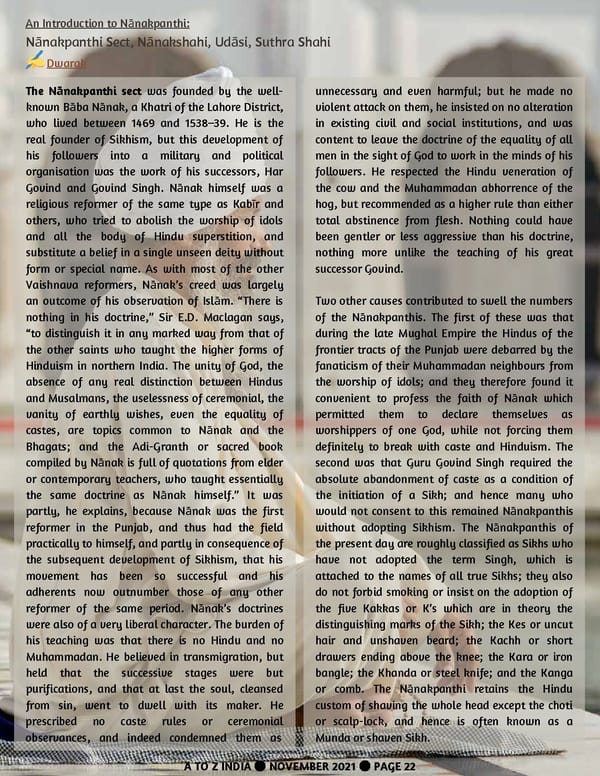An Introduction to Nānakpanthi: Nānakpanthi Sect, Nānakshahi, Udāsi, Suthra Shahi Dwarak The Nānakpanthi sect was founded by the well- unnecessary and even harmful; but he made no known Bāba Nānak, a Khatri of the Lahore District, violent attack on them, he insisted on no alteration who lived between 1469 and 1538–39. He is the in existing civil and social institutions, and was real founder of Sikhism, but this development of content to leave the doctrine of the equality of all his followers into a military and political men in the sight of God to work in the minds of his organisation was the work of his successors, Har followers. He respected the Hindu veneration of Govind and Govind Singh. Nānak himself was a the cow and the Muhammadan abhorrence of the religious reformer of the same type as Kabīr and hog, but recommended as a higher rule than either others, who tried to abolish the worship of idols total abstinence from flesh. Nothing could have and all the body of Hindu superstition, and been gentler or less aggressive than his doctrine, substitute a belief in a single unseen deity without nothing more unlike the teaching of his great form or special name. As with most of the other successor Govind. Vaishnava reformers, Nānak’s creed was largely an outcome of his observation of Islām. “There is Two other causes contributed to swell the numbers nothing in his doctrine,” Sir E.D. Maclagan says, of the Nānakpanthis. The first of these was that “to distinguish it in any marked way from that of during the late Mughal Empire the Hindus of the the other saints who taught the higher forms of frontier tracts of the Punjab were debarred by the Hinduism in northern India. The unity of God, the fanaticism of their Muhammadan neighbours from absence of any real distinction between Hindus the worship of idols; and they therefore found it and Musalmans, the uselessness of ceremonial, the convenient to profess the faith of Nānak which vanity of earthly wishes, even the equality of permitted them to declare themselves as castes, are topics common to Nānak and the worshippers of one God, while not forcing them Bhagats; and the Adi-Granth or sacred book definitely to break with caste and Hinduism. The compiled by Nānak is full of quotations from elder second was that Guru Govind Singh required the or contemporary teachers, who taught essentially absolute abandonment of caste as a condition of the same doctrine as Nānak himself.” It was the initiation of a Sikh; and hence many who partly, he explains, because Nānak was the first would not consent to this remained Nānakpanthis reformer in the Punjab, and thus had the field without adopting Sikhism. The Nānakpanthis of practically to himself, and partly in consequence of the present day are roughly classified as Sikhs who the subsequent development of Sikhism, that his have not adopted the term Singh, which is movement has been so successful and his attached to the names of all true Sikhs; they also adherents now outnumber those of any other do not forbid smoking or insist on the adoption of reformer of the same period. Nānak’s doctrines the five Kakkas or K’s which are in theory the were also of a very liberal character. The burden of distinguishing marks of the Sikh; the Kes or uncut his teaching was that there is no Hindu and no hair and unshaven beard; the Kachh or short Muhammadan. He believed in transmigration, but drawers ending above the knee; the Kara or iron held that the successive stages were but bangle; the Khanda or steel knife; and the Kanga purifications, and that at last the soul, cleansed or comb. The Nānakpanthi retains the Hindu from sin, went to dwell with its maker. He custom of shaving the whole head except the choti prescribed no caste rules or ceremonial or scalp-lock, and hence is often known as a observances, and indeed condemned them as Munda or shaven Sikh. A TO Z INDIA ● NOVEMBER 2021 ● PAGE 22
 A TO Z INDIA - NOVEMBER 21 Page 21 Page 23
A TO Z INDIA - NOVEMBER 21 Page 21 Page 23